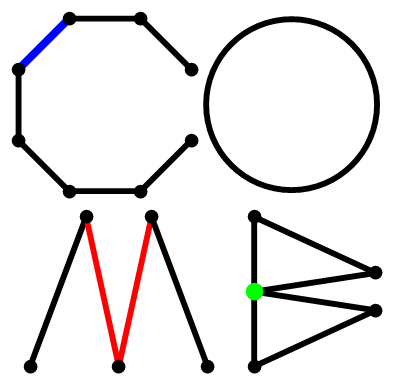Hakata Workshop;Winter Meeting 2018
Last-modified: 2018-02-21 (水) 08:48:01
Top/Hakata Workshop;Winter Meeting 2018
Hakata Workshop; Winter Meeting 2018†
~Discrete Mathematics and its Applications~
Our purpose of this meeting is giving an opportunity to make a speech and to communicate with researchers who study various fields not only Combinatorics.
Further information is available from the organizers below.
Organizers†
- Yoshihiro Mizoguchi (Kyushu University),
- Tetsuji Taniguchi (Hiroshima Institute of Technology),
- Osamu Shimabukuro (Nagasaki University),
- Makoto Tagami (Kyushu Institute of Technology),
- Hirotake Kurihara (Kitakyushu National College of Technology),
- Shuya Chiba (Kumamoto University),
- Tsuyoshi Miezaki (University of the Ryukyus),
- Daniel GAINA (Kyushu University).
Supported by†
- Graduate School of Mathematics, Kyushu University
- JSPS KAKENHI(Grant-in-Aid for Scientific Research (C)) Grant Number 25400217.
- JSPS KAKENHI(Grant-in-Aid for Scientific Research (C)) Grant Number 17K05346
Date†
February 22 and 23, 2018
Location†
- Thursday,February 22 九州大学伊都キャンパス(福岡市西区元岡744)ウェスト1号館D棟4階オーディトリアム前ホワイエ(see https://www.kyushu-u.ac.jp/ja/campus/ito/)
- Friday,February 23 Seminar Room Y-2 (2F) in Reference Eki Higashi Building. 1-16-14 Hakata-Eki-Higashi, Hakata-Ku, Fukuoka City, 812-0013 (see http://www.re-rental.com/ , Google maps )
Program†
- Thursday,February 22
- Friday,February 23
Speaker Title 12:57--13:00 Opening (Tetsuji Taniguchi) 13:00-13:40 Takeshi Hatanaka (Tokyo Institute of Technology) Passivity-Based Control and Optimization: From Networked Robotics to Multi-agent Optimization 13:50-14:30 Akihiro Higashitani (Kyoto Sangyo University, Faculty of Science) Characterization problem on Ehrhart polynomials of lattice polytopes 14:40-15:20 Hiroshi Tamaru (Hiroshima University) Flat quandles and finite subsets in symmetric spaces 15:30-16:00 Chiaki Nishijima (Kyushu University) The calculation of eigenvalues of cycles and paths using Chebyshev polynomials 16:20-17:00 Shohei Satake (Graduate School of System Informatics, Kobe University) Constructions of n-e.c. graphs and tournaments 17:10-17:50 Takanori Yasuda (Okayama university of science) Cryptography Having a Resistance Against Quantum Computer 17:50--17:55 Closing(Yoshihiro Mizoguchi)
List of Poster session speakers†
Software in Mathematics Demonstration Track in Hakata Workshop 2017†
- 肖 俊廷 (九州大学大学院数理学府) Efficient implementation of discrete Gaussian sampling for lattice-based cryptography on multiple platforms
- 宮木 希 (九州大学大学院数理学府) レイアウト問題の整数計画法を用いた解法
- 平河 尭 (九州大学大学院数理学府) 論理式表現された問題の混合整数計画問題への自動変換
- 山田 智史 (九州大学大学院数理学府) Free Fem++を用いて作成したメッシュ上での数値計算
- 池松 泰彦 (九州大学IMI) GVWアルゴリズムの改良と実験結果
- 松藤 ちひろ (九州大学大学院数理学府) 最適化された回転中心を用いた実時間スキニングアルゴリズムのBlenderでの実装
- 安東 昂希 (九州大学理学部数学科) 計算体系に基づく古典論理の自動定理証明器の実装
Abstract†
Takeshi Hatanaka†
- Title: Passivity-Based Control and Optimization: From Networked Robotics to Multi-agent Optimization
- Abstract: This talk is intended to review a series of our works related to a notion called passivity. In the former half, we address distributed robot motion coordination.This part start with general results on passivity-based output synchronization.The foundations therein are then shown to play a key role in achieving the objective. The presented control architecture is then extended to a scenario of interactions between the robotic swarm and a human. The subject treated in the latter half is multi-agent optimization, wherein we present a perspective that solution processes for the intended problems are regarded as interconnections of passive systems. We finally exemplify benefits of the present perspective by scenarios of 3D human localization for camera networks and co-optimization of multiple connected buildings.
Akihiro Higashitani†
- Title:Characterization problem on Ehrhart polynomials of lattice polytopes
- Abstract: One of the most important invariants of a lattice polytope is the Ehrhart polynomial encoding the number of lattice points contained in its integral dilation. In this talk, after surveying the Ehrhart polynomials of lattice polytopes and their fundamental properties, we will focus on the characterization problem on the Ehrhart polynomials and give some recent results.
Hiroshi Tamaru†
- Title:Flat quandles and finite subsets in symmetric spaces
- Abstract: In this talk, we overview our recent studies on some interplays between quandles and symmetric spaces. By applying an idea of symmetric spaces, we have defined the notion of flat quandles. Furthermore, some finite subsets (subquandles) in symmetric spaces provide interesting examples of flat quandles. These examples enable us to introduce the notion of s-commutative subsets in symmetric spaces, which is a generalization of antipodal sets.
Chiaki Nishijima†
- Title:The calculation of eigenvalues of cycles and pathes using Chebyshev polynomials
- Abstract:
If we want to calculate the eigenvalues of the path of length n, first we often calculate the eigenvalues of the cycle of length
. But if we use the Chebyshev polynomials of the second kind, we can directly get the eigenvalues of the path. I introduce the technique of the calculation.
Shohei Satake†
- Title:Constructions of
-e.c. graphs and tournaments
- Abstract:
The
-e.c. property is a typical property of Erd\H{o}s-R\'{e}nyi random graphs (or tournaments). The
-e.c. property leads us to a generalization of the Sh\"{u}tte-Erd\H{o}s problem which asks the existence of tournaments such that there is a dominating vertex for all
vertices. This property also gives a solution to the problem of full graphs, that is, graphs which contain all ``small’’ graphs. In this talk, we give some constructions of
-e.c. graphs and tournaments. Moreover, we also explain applications to other problems.
Takanori Yasuda†
- Title:Cryptography Having a Resistance Against Quantum Computer
- Abstract: It has been already shown that the current public key system is broken by using property of a quantum computer. A quantum computer having the expected property does not exist yet now, but, it is urgently necessary to develop cryptography having a resistance against quantum computer, post-quantum cryptography. Multivariate public key cryptosystem is one of candidates of post-quantum cryptography. I will explain the principle and applications of this system.
